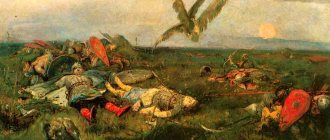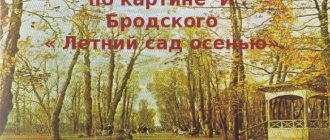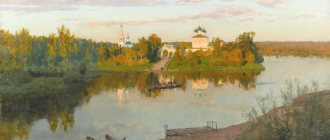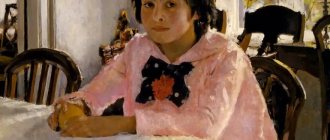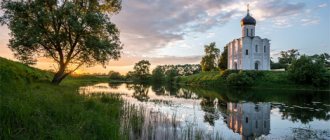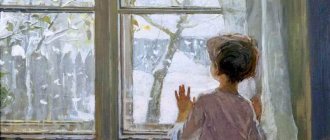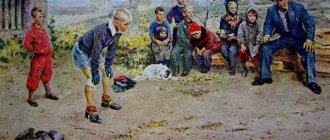The famous artist of the times of the Soviet Union, Igor Emmanuilovich Grabar, was known for his works in the field of art history, painting, and was an excellent teacher, professor and restorer. The creative career of the painter has brought many wonderful works of art into our century. Of these artistic assets, one of the most popular paintings by Grabar is “February Azure”. Visiting his favorite Tretyakov Gallery as a child, in 1913 Grabar became its director. Later, he became interested in architecture, the history of modern art, was actively involved in museum affairs and became an activist for the protection of historically significant monuments. Grabar created many works devoted to museum topics and architecture, and published a large number of books on these topics. In addition to winter landscapes, the author painted still lifes, painted portraits of loved ones, self-portraits, but his special love for creativity arose in the winter, when snow fell on his favorite tree - the weeping birch.
The history of the creation of the painting “February Blue”
This landscape was created in 1904. As materials, Igor Emmanuilovich used canvas and oil. The canvas measures 141 x 83 centimeters. At the moment, the painting is stored in the State Tretyakov Art Gallery in Moscow. This unique work is written in the style of impressionism. The talented painter in his work was able to convey not only the outlines of the landscape itself, but also all the realism of a winter snowy day in a birch grove.
The author of the canvas wrote her winter creation during the visit of her friends to the Moscow region. One of the walks near the house ended with the inspiration of the coming spring; being already an experienced master of the brush, the painter was quickly able to show his mood on canvas. I. Grabar admitted many times that one of his favorite trees is birch. He painted his landscape in several stages, which lasted for two weeks. One day he made small sketches, the next day he dug a special ditch in the snow, where the author created the work. Thus, everyone’s favorite landscape “February Azure” was born.
Description of the painting by Igor Grabar “February Blue”
February Azure, Igor Grabar, 1904, Tretyakov Gallery, landscape. Photo: https://ru.wikipedia.org
| Name | February blue |
| Country, artist | Russia, Igor Grabar |
| Year | 1904 |
| Genre | scenery |
| Where is it stored? | Tretyakov Gallery, Moscow |
| Materials | canvas, oil |
Winter landscape, February frost, a lot of white and a lot of blue.
The blue sky echoes white birch trees, white snow and frosty fresh air. The forest is still shrouded in snow, it is still sleeping, but the first signs of an early spring are already visible. In the foreground are pictures of birches, very tall birches. It was written as if the artist was sitting, or even lying under the trees. This technique gives the picture greater volume and openness, as if you can even feel the frosty air of the grove.
There are a lot of light colors in the picture, and it would seem that it should be a big bright spot. But the canvas does not seem oversaturated with white and blue tones. Spots of branches and shadows of trees, rare glimpses of pre-spring thawed patches in the snow. All this gives the picture newness, future life and a premonition of spring riots.
The colors on the canvas are scattered, and if you stand and look closely, you will notice that the sky, shimmering with azure, gives it to the last February snow, through which pieces of branches broken off last year are already visible here and there.
If you look at the trees, you can see that their branches were bent from the snow and winds. And now they are hanging loosely in different directions, waiting for the real warm spring sun. Looking at the birch trees, you involuntarily begin to think about the immediate warm rays of the sun, the chirping of birds, the murmuring of brooks. And the birches are also waiting, a few more days, and the long-awaited awakening will come, the branches will rise to the sun, and will be filled with fragrant buds.
A light spring breeze will knock last year's dry leaves off the branches and a new cycle will begin, new greenery, new life. It was precisely this effect, a premonition of awakening, that the master tried to achieve. And if, looking at the picture, you also took a deep breath, anticipating the imminent spring, then the artist succeeded.
Here and there you can still see laces of frost, caught and woven by frost, as if the birch trees were dressed up in beads. Slender, beautiful Russian birch trees, a little sleepy, but still beautiful, will soon throw off their frost beads to put on a green sundress with thousands of birch earrings.
The last wait, a quiet sunny azure farewell to frosty February. Even in the title of the painting there is already a hint of a quick awakening, of the fact that this azure is saying goodbye to the forest, to the sky, to the earth. And life goes on.
Painting technique
Thanks to a certain method of the artist’s work, the paintings acquired a unique look. Working in a trench, Grabar depicts birch trees pointing upward; this technique came to his mind one day when he dropped his brush on the snow. Raising his head, he was speechless, because the top of the birch tree from the level of the snow surface took on marvelous shapes, and the colors played with completely different colors. To prevent the sun from negatively affecting the paints, the painter had to place the canvas facing the sky. Often while painting, he used an umbrella to prevent thawed snow from dripping from the birch tree. The painter's work lasted almost continuously. According to him, this was his most important period in the creation of this work.
Grabar “February Azure”, created in maximum color saturation. The author loved to work in the fresh air, he explained this by the fact that from the window the colors of the landscape are not so bright and look different. The landscape was painted in pure color, the strokes applied in dense layers. Thanks to this paint application technique, the specific volume of tree trunks, the design of branches and snow cover were determined. Looking at the birch trees from a low point, the artist has the opportunity to use the full depth of colors, from light green below to all shades of blue above. Every detail of the picture is carefully drawn. A tractor can be seen in the background of the canvas, this tells the viewer that the birch trees are in the field, perhaps there is a settlement nearby. Igor Emmanuilovich perfectly mastered impressionism; the artist liked this artistic style. Thanks to the unique writing, Russian landscapes acquired a new look, where rainbow colors create the illusion of space and light on the canvases.
In other works of the author, you can see that he paid special attention to winter. In the summer, he painted still lifes. Winter, with sparkling snow, fabulous frost, and sun glare from icy surfaces, best inspired the artist’s inimitable winter compositions.
FEBRUARY AZURIgor Grabar
The honorary title of Honored Artist was established in our country in 1928, and the first artist to receive it was Igor Emmanuilovich Grabar. Indeed, his services to Russian and Soviet art are very significant. A remarkable artist and an outstanding restorer, a tireless researcher and an active organizer of the Society for the Protection of Ancient Monuments, a museum worker - this is not a complete list of the activities in which I. Grabar’s talent was manifested. He himself said: “Just as I could not live without art, so I could not live a day without labor.”
I. Grabar served art as a painter and artist, as an art historian and as an art critic. His path as a painter is very long, and there are few artists who can show their works painted over more than sixty years. A I.E. At his anniversary exhibition in 1951, Grabar demonstrated both works from the end of the last century and those that had received the final touches just before the vernissage.
He could never simply contemplate the world around him and always sought to capture it in colors. I. Grabar the artist is characterized mainly by two painting genres - landscape and portrait. He discovered a new Russian landscape, and not every painter is given the happiness of seeing the old in a new way, of showing the unusual in the ordinary.
I. Grabar began to try his hand at landscape painting back in the late 1880s, when he painted “Roof with Snow.” This canvas foreshadowed one of the main themes of I. Grabar’s landscape painting - the theme of Russian winter and Russian snows. This theme especially captured the artist in the first decade of our century, and subsequently reminded of itself more than once. According to I. Grabar himself, he always strived for “objective truth in painting”; He set himself the educational task of “conveying nature to the point of complete illusion, to the point of impossibility of distinguishing between nature and canvas with painting.”
The main early landscapes of I. Grabar were created in 1903-1908. The year 1904 was especially successful for the artist, when he painted such paintings as “Rooks’ Nests,” “March Snow” and “February Blue.” It was these landscapes that primarily attracted the attention of viewers at the exhibition of the Union of Russian Artists in 1904. Critics called I. Grabar’s canvases “almost the best at the exhibition,” because it’s rare to see someone “like his, conveying nature.” But at that time he was a young artist, just beginning his creative path. Success with the public and critics was especially important because the “Union of Russian Artists” was at that time the leading exhibition association, which included the most gifted artists in its ranks.
And I. Grabar wrote his “February Azure” in the winter and spring of 1904, when he was visiting friends in the Moscow region. During one of his usual morning walks, he was struck by the holiday of the awakening spring, and subsequently, being already a venerable artist, very vividly told the story of the creation of this canvas. “I stood near a marvelous specimen of birch, rare in the rhythmic structure of its branches. Looking at her, I dropped the stick and bent down to pick it up. When I looked at the top of the birch from below, from the surface of the snow, I was stunned by the spectacle of fantastic beauty that opened before me: some kind of chimes and calls of all the colors of the rainbow, united by the blue enamel of the sky. Nature seemed to be celebrating some unprecedented festival of azure skies, pearl birches, coral branches and sapphire shadows on lilac snow.” It is not surprising that the artist passionately wanted to convey “at least a tenth of this beauty.”
I. Grabar has repeatedly admitted that of all the trees in central Russia, he loves the birch most, and among the birches, his “weeping” variety. And indeed, in “February Azure”, birch is the only basis of the artistic image. The very appearance of this tree, the ability to see its charm in the general structure of the Russian landscape, reflected the artist’s joyful perception of the nature of the Russian region, which distinguished I. Grabar the landscape painter in all periods of his work.
This time, the artist quickly returned home to get the canvas, and then in one session he sketched a sketch of the future painting from life. The next day, taking another canvas, he began to paint a sketch from the same place, which became everyone’s favorite “February Blue.” I. Grabar worked on this painting outdoors, in a deep trench that he specially dug in the snow. The artist painted “February Blue” “with an umbrella painted blue, and placed the canvas not only without the usual tilt forward, facing the ground, but turned its face to the blue of the sky, which is why reflexes from the hot snow under the sun did not fall on it, and he remained in the cold shadow, forcing... to triple the power of color to convey the fullness of the impression.”
In “February Blue” I. Grabar achieved extreme color saturation; he painted this landscape in pure color, applying brush strokes in a dense layer. It was precisely these tiny strokes that revealed the volumes of tree trunks, the patterns of branches, and the mounds of snow. The low point of view opened up the opportunity for the artist to convey all the gradations of blue - from light green at the bottom to ultramarine at the top.
I. Grabar was called (and he himself did not deny this) the last of the plein air painters of Russia. But, having mastered the best achievements of impressionism, he found his own artistic style in art - unique and original. The nature of Russia acquired a completely new look in his landscapes, sparkled with rainbow colors, and was filled with a feeling of space and light. In this regard, I. Grabar continued and developed the principles that appeared in the works of I. Levitan, V. Serov, K. Korovin and other outstanding Russian landscape painters.
It has been repeated more than once that I. Grabar entered the history of Russian painting as the poet of Russian winter (although he painted both spring and autumn). But the winters of I. Grabar, his birches, snow are conceivable only here, only in Russia. The artist always considered this painting to be the most sincere and most pleasing work of his mature creativity.
Table of contents
Description of the picture
The foreground of the canvas presents the viewer with a birch tree, which has majestically spread its branches, filling almost the entire space of the canvas. The unique writing style and perspective made the work not just a beautiful work of art, but also an unsurpassed masterpiece. Reading this composition, you can catch the meaning in its little details. The elusive Russian nature attracts and excites the heart; one can say that this birch is the “Russian soul”. The author’s love for the Russian winter is often expressed in his works; the author also has a special relationship with weeping birches; it is this type of birch that he loves most. “February Azure” carries a foreshadowing of spring. The bright sun begins to shine more and more, and the frosts intensively recede. Despite all the charm, this work carries a certain sadness for the passing winter.
A painting painted in a trench
In order to be able to observe the landscape from this particular point of view while working, the master had to make some physical efforts. He took a shovel from the utility room of his friend’s house and dug a hole half the size of a man. When the trench was ready, the artist moved there an easel, paints and other supplies necessary for working on the painting “February Blue”.
The air temperature at this time was not too low, so the painter could afford to spend several hours a day outdoors. He did not arrange the canvas in the traditional way, but placed it at an angle, so that the drawing looked down at an acute angle.
By this, the artist achieved constant shading of the canvas. With insufficient lighting, the colors seemed dull to him, and he was forced to use the brightest shades. For this reason, Grabar’s painting “February Blue” acquired festive, sparkling tones.
